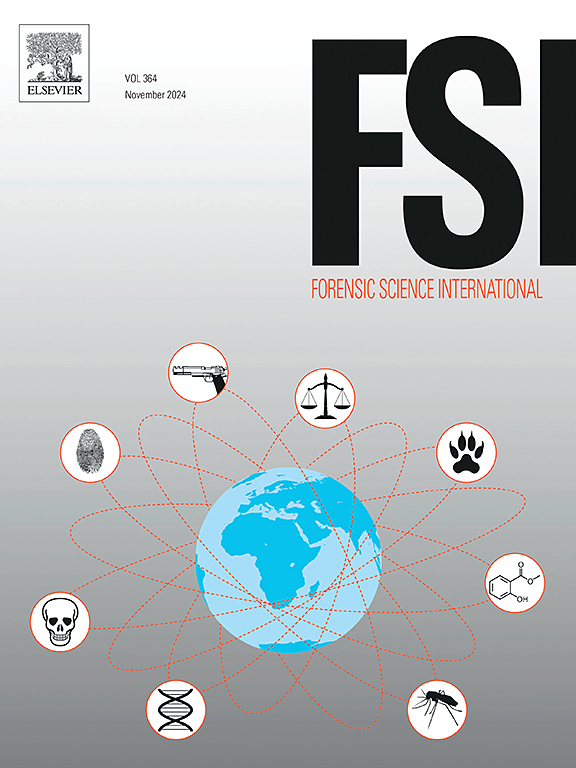Analysis of the health conditions of migrants and asylum seekers in reception centers: From scene investigation to the evaluation of signs of torture
IF 2.2
3区 医学
Q1 MEDICINE, LEGAL
引用次数: 0
Abstract
The phenomenon of migration is an international issue that mainly concerns Europe. In Italy, because of its close proximity to Africa, there are many migrant landings, especially on the islands of Lampedusa and Sicily. Migrants and asylum seekers suffer torture on their journey to their destination country, however, most of the time the signs are not always recognizable. In the present study, a scene investigation was carried out in a reception center for level II immigrants in Sicily, in order to evaluate the hygiene conditions of the migrants and asylum seekers inside this center. Subsequently 26 migrants and asylum seekers, all minors and males, were examined in a clinic of the Department of Forensic Medicine of the University of Catania, with the help of a native speaker interpreter and applying the Istanbul Protocol. The scene investigation demonstrated the poor clinical conditions of the reception center and the failure to comply with emergency regulations. The physical examination of the migrants and asylum seekers demonstrated that all the torture reported had taken place in Libya. However, only 4 migrants and asylum seekers showed signs of violence consistent with torture, compatible with the Istanbul Protocol. Nine migrants and asylum seekers (34.6 %) reported having pathologies and asked to undergo a medical examination in a hospital but were not listened to by the reception center staff. Two migrants and asylum seekers reported having worn the same clothes for several weeks to the reception center staff. In particular, all the migrants and asylum seekers reported having suffered torture using blunt instruments, especially beatings with truncheons. One migrant and asylum seeker reported being detained for days without food, instead 1 migrants and asylum seekers reported being kidnapped-blindfolded-stripped naked for days, and 1 migrants and asylum seekers reported having contracted infections, including scabies, with electrical and thermal trauma. Despite the international commitment to the phenomenon of migration, migrants and asylum seekers continue to receive abuse and torture. Furthermore, most migrants and asylum seekers studies primarily involve surveys, and few have applied the Istanbul Protocol to a sizable sample. An original aim of the study is the use of forensic tools to assess the sanitary and hygienic conditions of a migrant reception center, with the secondary aim of assessing alleged cases of torture.
分析接待中心移民和寻求庇护者的健康状况:从现场调查到酷刑迹象评估。
移民现象是一个主要涉及欧洲的国际问题。在意大利,由于毗邻非洲,有许多移民登陆,特别是在兰佩杜萨岛和西西里岛。移民和寻求庇护者在前往目的地国的途中遭受酷刑,但大多数情况下,这些迹象并不总能被识别出来。本研究在西西里岛的一个二级移民接待中心进行了现场调查,以评估该中心内移民和寻求庇护者的卫生条件。随后,26 名移民和寻求庇护者(均为未成年人和男性)在卡塔尼亚大学法医系的一家诊所接受了检查,检查由一名母语为翻译的人员协助,并采用了《伊斯坦布尔议定书》。现场调查表明,接待中心的医疗条件很差,而且没有遵守紧急条例。对移民和寻求庇护者的身体检查表明,所有报告的酷刑都发生在利比亚。然而,只有 4 名移民和寻求庇护者出现了符合《伊斯坦布尔议定书》规定的酷刑暴力迹象。九名移民和寻求庇护者(占 34.6%)报告称患有疾病,并要求到医院进行体检,但接待中心的工作人员没有听取他们的意见。两名移民和寻求庇护者向接待中心工作人员报告说,他们几个星期都穿着同样的衣服。特别是,所有移民和寻求庇护者都报告说遭受了使用钝器的酷刑,尤其是用警棍殴打。一名移徙者和寻求庇护者报告说,他们被拘留数日,没有食物,一名移徙者和寻求庇护者报告说,他们被绑架--蒙上眼睛--赤身裸体数日,一名移徙者和寻求庇护者报告说,他们因电击和热创伤而感染疾病,包括疥疮。尽管国际社会对移徙现象做出了承诺,但移徙者和寻求庇护者继续受到虐待和酷刑。此外,大多数关于移民和寻求庇护者的研究主要涉及调查,很少有研究将《伊斯坦布尔议定书》应用于相当大的样本中。这项研究的最初目的是使用法医工具评估移民接待中心的卫生条件,其次是评估指控的酷刑案件。
本文章由计算机程序翻译,如有差异,请以英文原文为准。
求助全文
约1分钟内获得全文
求助全文
来源期刊

Forensic science international
医学-医学:法
CiteScore
5.00
自引率
9.10%
发文量
285
审稿时长
49 days
期刊介绍:
Forensic Science International is the flagship journal in the prestigious Forensic Science International family, publishing the most innovative, cutting-edge, and influential contributions across the forensic sciences. Fields include: forensic pathology and histochemistry, chemistry, biochemistry and toxicology, biology, serology, odontology, psychiatry, anthropology, digital forensics, the physical sciences, firearms, and document examination, as well as investigations of value to public health in its broadest sense, and the important marginal area where science and medicine interact with the law.
The journal publishes:
Case Reports
Commentaries
Letters to the Editor
Original Research Papers (Regular Papers)
Rapid Communications
Review Articles
Technical Notes.
 求助内容:
求助内容: 应助结果提醒方式:
应助结果提醒方式:


